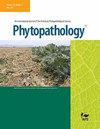求助PDF
{"title":"揭示无菌条件下 Pinus massoniana 对 Bursaphelenchus xylophilus 的防御机制:转录组分析","authors":"Jinghui Zhu, Kean-Jin Lim, Tianyu Fang, Chen Zhang, Jianren Ye, Li-Hua Zhu","doi":"10.1094/PHYTO-06-24-0180-R","DOIUrl":null,"url":null,"abstract":"<p><p>Pine wilt disease (PWD) is caused by the pine wood nematode (PWN, <i>Bursaphelenchus xylophilus</i>) and significantly impacts pine forest ecosystems globally. This study focuses on <i>Pinus massoniana</i>, an important timber and oleoresin resource in China, which is highly susceptible to PWN. However, the defense mechanism of pine trees in response to PWN remains unclear. Addressing the complexities of PWD, influenced by diverse factors such as bacteria, fungi, and environment, we established a reciprocal system between PWN and <i>P. massoniana</i> seedlings under aseptic conditions. Utilizing combined second- and third-generation sequencing technologies, we identified 3,718 differentially expressed genes post PWN infection. Transcript analysis highlighted the activation of defense mechanisms via stilbenes, salicylic acid and jasmonic acid pathways, terpene synthesis, and induction of pathogenesis-related proteins and resistance genes, predominantly at 72 h postinfection. Notably, terpene synthesis pathways, particularly the mevalonate pathway, were crucial in defense, suggesting their significance in <i>P. massoniana</i>'s response to PWN. This comprehensive transcriptome profiling offers insights into <i>P. massoniana</i>'s intricate defense strategies against PWN under aseptic conditions, laying a foundation for future functional analyses of key resistance genes. [Formula: see text] Copyright © 2024 The Author(s). This is an open access article distributed under the CC BY 4.0 International license.</p>","PeriodicalId":20410,"journal":{"name":"Phytopathology","volume":" ","pages":"2525-2535"},"PeriodicalIF":2.6000,"publicationDate":"2024-12-01","publicationTypes":"Journal Article","fieldsOfStudy":null,"isOpenAccess":false,"openAccessPdf":"","citationCount":"0","resultStr":"{\"title\":\"Unraveling <i>Pinus massoniana</i>'s Defense Mechanisms Against <i>Bursaphelenchus xylophilus</i> Under Aseptic Conditions: A Transcriptomic Analysis.\",\"authors\":\"Jinghui Zhu, Kean-Jin Lim, Tianyu Fang, Chen Zhang, Jianren Ye, Li-Hua Zhu\",\"doi\":\"10.1094/PHYTO-06-24-0180-R\",\"DOIUrl\":null,\"url\":null,\"abstract\":\"<p><p>Pine wilt disease (PWD) is caused by the pine wood nematode (PWN, <i>Bursaphelenchus xylophilus</i>) and significantly impacts pine forest ecosystems globally. This study focuses on <i>Pinus massoniana</i>, an important timber and oleoresin resource in China, which is highly susceptible to PWN. However, the defense mechanism of pine trees in response to PWN remains unclear. Addressing the complexities of PWD, influenced by diverse factors such as bacteria, fungi, and environment, we established a reciprocal system between PWN and <i>P. massoniana</i> seedlings under aseptic conditions. Utilizing combined second- and third-generation sequencing technologies, we identified 3,718 differentially expressed genes post PWN infection. Transcript analysis highlighted the activation of defense mechanisms via stilbenes, salicylic acid and jasmonic acid pathways, terpene synthesis, and induction of pathogenesis-related proteins and resistance genes, predominantly at 72 h postinfection. Notably, terpene synthesis pathways, particularly the mevalonate pathway, were crucial in defense, suggesting their significance in <i>P. massoniana</i>'s response to PWN. This comprehensive transcriptome profiling offers insights into <i>P. massoniana</i>'s intricate defense strategies against PWN under aseptic conditions, laying a foundation for future functional analyses of key resistance genes. [Formula: see text] Copyright © 2024 The Author(s). This is an open access article distributed under the CC BY 4.0 International license.</p>\",\"PeriodicalId\":20410,\"journal\":{\"name\":\"Phytopathology\",\"volume\":\" \",\"pages\":\"2525-2535\"},\"PeriodicalIF\":2.6000,\"publicationDate\":\"2024-12-01\",\"publicationTypes\":\"Journal Article\",\"fieldsOfStudy\":null,\"isOpenAccess\":false,\"openAccessPdf\":\"\",\"citationCount\":\"0\",\"resultStr\":null,\"platform\":\"Semanticscholar\",\"paperid\":null,\"PeriodicalName\":\"Phytopathology\",\"FirstCategoryId\":\"97\",\"ListUrlMain\":\"https://doi.org/10.1094/PHYTO-06-24-0180-R\",\"RegionNum\":2,\"RegionCategory\":\"农林科学\",\"ArticlePicture\":[],\"TitleCN\":null,\"AbstractTextCN\":null,\"PMCID\":null,\"EPubDate\":\"2024/12/16 0:00:00\",\"PubModel\":\"Epub\",\"JCR\":\"Q2\",\"JCRName\":\"PLANT SCIENCES\",\"Score\":null,\"Total\":0}","platform":"Semanticscholar","paperid":null,"PeriodicalName":"Phytopathology","FirstCategoryId":"97","ListUrlMain":"https://doi.org/10.1094/PHYTO-06-24-0180-R","RegionNum":2,"RegionCategory":"农林科学","ArticlePicture":[],"TitleCN":null,"AbstractTextCN":null,"PMCID":null,"EPubDate":"2024/12/16 0:00:00","PubModel":"Epub","JCR":"Q2","JCRName":"PLANT SCIENCES","Score":null,"Total":0}
引用次数: 0
引用
批量引用

 求助内容:
求助内容: 应助结果提醒方式:
应助结果提醒方式:


